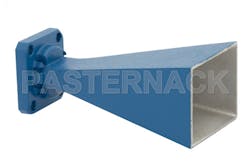There are many types of antennas to serve the various RF, microwave, and millimeter-wave applications. A very common antenna for microwave and millimeter-wave systems are horn antennas, which have been in use since the early 1900s. Horn antennas are essentially rectangular or circular waveguides that reduce the size of a waveguide or coaxial port at one end. Horn antennas exhibit a low voltage standing wave ratio (VSWR), a very wide bandwidth operation (10:1 and even 20:1 horn antennas are possible), are relatively simple and inexpensive to produce, and provide moderate directivity. The gain and SWR of horn antennas is also typically flat over the bandwidth, which is why they are well suited to testing other antennas performance.
Horn antennas are commonly used as directive antennas for radar, microwave radiometers, as feed horns for large antenna structures such as parabolic antennas, and as calibration and testing scenarios for testing other antennas. Many new 5G testing platforms and proof of concept prototypes also use horn antennas for their simplicity, and horn antennas are commonly used in channel sounders and other field testing apparatus. There are several different types and structures of horn antennas to serve these various applications.
Pyramidal Horn Antenna
This type of horn antenna is a common variety that looks like a rectangular, or square, pyramidal structure terminated in a waveguide port, typically rectangular waveguide.
Sectoral Horn Antenna
These types of horn antennas are identified by having one side of the horn antenna structure aligned with a wall of the terminating waveguide port, while the other sides of the horn antenna are flared out. Depending on the orientation of the flared and flat sides of a sectoral horn antenna, the antenna could be an E-plane or H-plan horn antenna.
Conical Horn Antenna
Instead of a rectangular pyramid structure, such as with a pyramidal horn antenna, a conical horn antenna is often a circular or elliptical cone terminated in a circular or elliptical waveguide. Though some conical horn antennas are terminated in rectangular waveguide.
Scalar Horn Antenna or Exponential Horn Antenna
Unlike a typical pyramidal, sectoral, or conical horn antenna, an exponential horn antenna variant of these types has an exponentially tapered side that creates a curved surface from the opening of the antenna to the waveguide termination. This method of construction minimizes the amount of internal reflections and allows for a consistent impedance and electrical performance over a very wide bandwidth.
Corrugated Horn Antenna
A corrugated horn antenna has sidewalls of the antenna which are grooved or slotted on the inside surface of the antenna horn, and are transverse to the axis of the antenna. These design features, which are electrically small compared to the wavelength of operation, enable very low side lobes and cross-polarization levels over the bandwidth. These types of antennas are often used in satellite and radio telescope applications.
Gain Horn Antenna
Gain horn antennas are horn antennas with a high and consistent gain over a broad bandwidth. These horn antennas are often used in the testing of other antennas, for radar, and for satellite and space applications.
Feed Horn Antenna
A feed horn antenna is simply a horn antenna which is used to transmit and receive signals from the RF and microwave electronics to the parabolic reflector commonly used for satellite dishes and radio telescopes.

